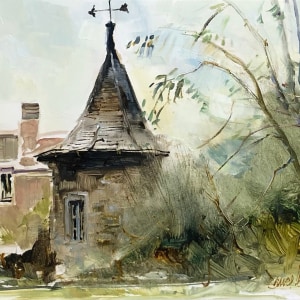-
Œuvres d'art
Bruce LeDainMartello Tower, Le Grand séminaire de Saint Sulpice, 19821928-2000Oil on hardboard7 7/8 x 12 1/8 in
20 x 30.5 cmSoldInscriptions
signed, dated and titled, 'Martello Tower, le grand seminaire de St Sulpice / Bruce le Dain / 1982' (verso)Provenance
Estate of Mr. & Mrs. Robert Lewis Munro.
Bruce LeDain has found as subject matter one of two existing Sulpician Towers originally built at the end of the 17th Century as part of Fort de la Montagne.
According to Canada’s Historic Places (1) these two towers were once the bastions of a fort built at the end of the 17th century by M. de Belmont for the Sulpicians of the neighbouring Indian mission of Notre-Dame-des-Neiges; the west tower housed the school of Marguerite Bourgeoys, and the east tower, the nuns of the Congregation. Around 1676, the Sulpicians of Montréal Island founded a mission, known as the Mission de la Montagne, intended for the instruction of local aboriginals and their conversion to Catholicism. In 1681, M. François Vachon de Belmont was named a superior of the mission which housed over 200 Iroquois, Hurons and Algonquins living in cabins within the fort.
In 1694, a stone fort composed of four towers connected by a stone enclosure wall, was constructed to protect the new mission. The towers were built with gun-ports for the defence of the fort; however, they acted as a deterrent and were never used. In fact, the Sisters of the Congregation of Notre-Dame used the southwest tower for a school and the southeast tower as a residence for the nuns of the Congregation. With the increasing departure of the aboriginals between 1692 and 1705, the southeast tower was transformed into a chapel (1824) and the northwest and northeast towers were demolished (2).
Bruce Le Dain was a fine artist represented primarily by Galerie Walter Klinkhoff and Continental Gallery throughout a distinguished career that spanned 40 years. It was around 1976 when Bruce abandoned a successful career as an executive in the advertising industry to paint full time. Due to his commitment and discipline and dedication to anything he undertook, the Royal Canadian Academy of the Arts invited Bruce to become its president in order to navigate the Academy through some difficult financial problems. Bruce LeDain’s contribution to the arts is well respected and exemplified by this fine painting. He was also a strong humanitarian, notably with his efforts on behalf of Katimavik and Montreal’s Douglas Hospital.
Notes
1. Parks Canada. ‘Sulpician Towers / Fort de la Montagne National Historic Site of Canada,’ HistoricPlaces.ca, https://www.historicplaces.ca/en/rep-reg/place-lieu.aspx?id=14541 (accessed 24 November, 2020)
2. Historic Sites and Monuments Board of Canada, ‘Criteria, General Guidelines & Specific Guidelines, Spring 2007,’ accessed via parkscanadahistory.com (published online November 2008), http://parkscanadahistory.com/publications/evaluation-historic-significance-e-2008.pdf (accessed 24 November 2020)











